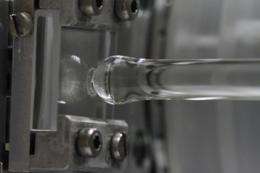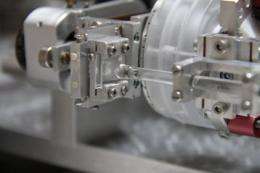Assessing an object's consistency without touching it

(Phys.org) -- Two teams of researchers have succeeded in evaluating the rigidity of a material … without touching it! To achieve this feat, physicists from the Laboratoire de Physique de la Matière Condensée et des Nanostructures (CNRS / Université Claude Bernard Lyon 1) and the Laboratoire de Physique des Solides (Université Paris-Sud / CNRS) placed a liquid–where they created a very weak, nanometric scale flow–between the probed object and the “tester”.
This technique, derived from the latest advances in nano-mechanics, has the advantage of being non-invasive and therefore non-destructive and could significantly improve the testing and analysis of thin, fragile objects such as bubbles or cells. This work is published on-line on June 18, 2012 on the website of the journal Physical Review Letters.
A simple way of determining whether a body is hard or soft is to touch it with a harder object. The problem with this technique is that it can destroy the item, especially if it is extremely fragile like a bubble or a living cell. Developing a less invasive alternative was therefore vital. To assess the rigidity of an object without touching it, the team of physicists had envisaged blowing on it delicately to check whether this flow of air deformed the material or not. But precisely controlling a flow of air is difficult on account of the vortexes that can form in the air. Hence the idea of using an easier-to-control “nano-flow” of fluid instead.

The researchers tested their technique on a thin elastomer (rubber) film, only several hundreds of nanometers (1) thick. In concrete terms, they placed the film on a rigid glass support and immersed the lot in a mixture of water and glycerol. They then created a very slight displacement of the liquid, near to the film. To generate this nano-flow, the physicists, and more particularly Samuel Leroy who was then working on his PhD at LPMCN (2), had to use a special device, developed in 2000 in the same laboratory (3). It comprises in particular a millimetric Pyrex (special glass) sphere, attached to a rod, which can be finely moved with what is known as a “piezoelectric ceramic” system. It is precisely this tiny glass bead that allows a nano-flow to be created at the surface of an object.
When the sphere comes up very close to the material (0.000001 meters), it pushes the liquid towards the object. This nano-flow generates a very slight pressure on the surface of the material. This force deforms the film very slightly, if it is flexible. On the other hand, if the tested object is completely rigid, the film remains unchanged.
The two teams also discovered that their method can be used to measure the rigidity of an array of bubbles, an element so fragile that touching it would mean destroying it! It is the first time that the possibility of measuring the elastic properties of an object using a nano-flow of fluid has been demonstrated. This initial work opens the way to a new nanometric-scale imaging technique for observing the elastic properties of very thin or thicker objects.
More information: Hydrodynamic interaction between a spherical particle and an elastic surface: A gentle probe for soft thin films. Samuel Leroy, Audrey Steinberger, Cécile Cottin-Bizonne, Frédéric Restagno, Liliane Léger and Elisabeth Charlaix. Physical Review Letters. 18 June 2012
Journal information: Physical Review Letters
Provided by CNRS

















